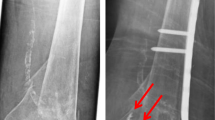Abstract
Purpose
Fractures of the condyle can be managed by open or by closed reduction. This study was designed to mention the complications of the bio-resorbable material we had experienced while using them in the management of condylar fractures.
Methods
Fifteen (11 men and four women) patients with subcondylar fractures were included in the study. Resorbable poly-l-lactide plates and screws were used for the fracture fixation. Patients were followed up clinically and radiographically for a period of 2 years.
Results
Seven patients had a satisfactory reduction following the placement of bio-resorbable plates. Three patients had developed a swelling in the pre-auricular region, extending till the angle. Two patients had a screw breakage whereby leading to malunion and three other patients had bone resorption, at the fractured site that was appreciated radiographically.
Conclusion
Inspite of the advantages of these materials, certain complications has been experienced in our study with regard to the resorption and degradation of the material which has been mentioned and explained in our article.





Similar content being viewed by others
References
Ellis E, Throckmorton GS (2005) Treatment of mandibular condylar process fractures: biological considerations. J Oral Maxillofac Surg 63:115–134
Hall MB (1994) Condylar fractures surgical management. J Oral Maxillofac Surg 52:1189–1192
McMahon J, Baker AW, Moos KF (1998) Current consensus of the management of fractures of the manbular condyle. A method by questionnaire. Int J Oral Maxillofac Surg 27:258
Suzuki T, Kawamura H, Kasahara T, Nagasaka H (2004) Resorbable poly-l lactide plates and screws for the treatment of mandibular condylar process fractures: a clinical and radiologic follow-up study. J Oral Maxillofac Surg 62:919–924
Undt G et al (1999) Transoral miniplate osteosynthesis of condylar neck fractures. Oral Surg Oral Med Oral Pathol Oral Radiol Endodontol 88:534
Sugiura T, Yamamoto K, Murakami K, Sugimura M (2001) A comparative evaluation of osteosynthesis with lag screws, miniplates, or kirschner wires for mandibular condylar process fractures. J Oral Maxillofac Surg 59:1161–1168
Bessho K, Iizuka T, Murakami KI (1997) A bioabsorbable poly-l-lactide miniplate and screw system for osteosynthesis in oral and maxillofacial surgery. J Oral Maxillofac Surg 55:941–945
Suuronen R, Pohjonen T, Hietanen J, Lindquist C (1998) A 5 year in vitro and in vivo study of the biodegradation of polylactide plates. J Oral Maxillofac Surg 56:604–614
Mathog RH (1984) Maxillofacial trauma, 1st edn. Williamsand Wilkins, Baltimore/London, pp 136–140
Santler G, Karcher H, Ruda C, Kole E (1999) Fractures of the condylar process: surgical versus non surgical treatment. J Oral Maxillofac Surg 57:392–397
Dahlstrom L, Kahnberg KE, Lindahl L (1989) 15 years follow-up on condylar fractures. Int J Oral Maxillofac Surg 18:18–23
Zide MF, Kent JN (1983) Indications for open reduction of mandibular condyle fractures. J Oral Maxillofac Surg 41:89–98
Ricalde P, Posnick JC (2004) Degradation rate of delta (resorbable) internal fixation: report of 2 cases. J Oral Maxillofac Surg 62:250–255
Bos RRM, Rozema FR, Boering G, Nijenhuis AJ, Pennings AJ, Verwey AB (1989) Bio-absorbable plates and screws for internal fixation of mandibular fractures—a study in six dogs. J Oral Maxillofac Surg 18:365–369
Bos RRM, Boering G, Rozema FR, Leenslag JW (1987) Resorbable poly (l-Lactide) plates and screws for the fixation of zygomatic fractures. J Oral Maxillofac Surg 45:751–753
Yerit KC, Enislidis G, Schopper C, Turhani D, Wanschitz F, Wagner A et al (2002) Fixation of mandibular fractures with biodegradable plates and screws. Oral Surg Oral Med Oral Pathol Oral Radiol Endodontol 94:294–300
Laughlin RM, Block MS, Wilk R, Malloy RB, Kent JN (2007) Resorbable plates for the fixation of mandibular fractures: a prospective study. J Oral Maxillofac Surg 65:89–96
Rasse M, Moser D, Zahl C, Gerlach KL, Ecklet U, Loukota R (2007) Resorbable poly (d, l) lactide plates and screws for osteosynthesis of condyla neck fractures in sheep. Br J Oral Maxillofac Surg 45:35–40
Bell RB, Kindsfater CS (2006) The use of biodegradable plates and screws to stabilize facial fracture. J Oral Maxillofac Surg 64:31–39
Wood GD (2006) Inion biodegradable plates: the first century. Br J Oral Maxillofac Surg 44:38–41
Ellis E, Throckmorton GS, Palmieri C (2000) Open treatment of condylar process fractures: assessment of adequacy of repositioning and maintenance of stability. J Oral Maxillofac Surg 58:27–34
Iizuka T, Ladrach K, Geering AH, Raveh J (1998) Open reduction without fixation of dislocated condylar process fractures: long term clinical and radiologic analysis. J Oral Maxillofac Surg 56:553–561
Wagner A, Krach W, Schicho K, Undt G, Ploder O, Ewers R (2002) A 3-dimensional finite-element analysis investigating the biomechanical behaviour of the mandible and plate osteosynthesis in cases of fractures of the condylar process. Oral Surg Oral Med Oral Pathol Oral Radiol Endodontol 94:678–686
Tams J, Otten B, Loon JPV, Rudolf RM (1999) A computer study of fracture mobility and strain on biodegradable plates used for fixation of mandibular fractures. J Oral Maxillofac Surg 57:973–981
Haug RH, Peterson GP, Goltz M (2002) A biomechanical evaluation of mandibular condyle fracture plating techniques. J Oral Maxillofac Surg 60:73–80
Author information
Authors and Affiliations
Corresponding author
Rights and permissions
About this article
Cite this article
Chaithanyaa, N., Rai, K.K., Arun kumar, K.V. et al. Setbacks of Bio-Resorbable Plates and Screws in the Management of Condylar Fractures: Our Experience. J. Maxillofac. Oral Surg. 10, 220–224 (2011). https://doi.org/10.1007/s12663-011-0237-6
Received:
Accepted:
Published:
Issue Date:
DOI: https://doi.org/10.1007/s12663-011-0237-6




